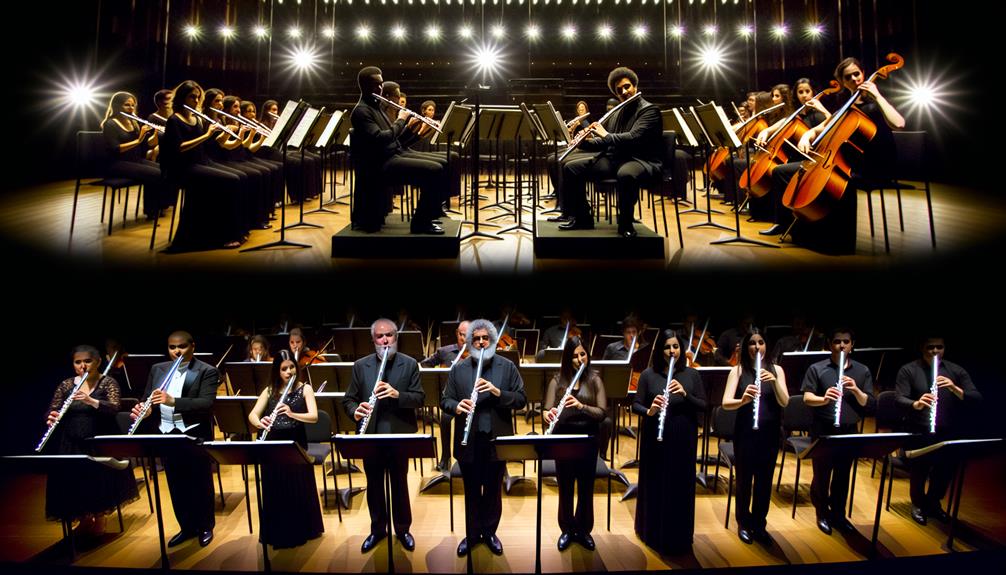In the symphonic realm, the flute section encompasses a range of tonal colors and textures, with the four distinct members each contributing their unique characteristics. From the high-pitched brilliance of the piccolo to the rich timbre of the bass flute, these instruments offer a diverse palette for composers to explore.
However, the roles and intricacies of each flute extend beyond mere variation in pitch and size. Understanding the nuances of the piccolo, concert flute, alto flute, and bass flute can provide valuable insights into the orchestration and sonic possibilities within this woodwind family.
Key Takeaways
- Piccolo: Small woodwind with a bright sound, three-octave range.
- Concert Flute: Key of C, bright sound, three-octave range.
- Alto Flute: Key of G, mellow tone, lower pitch, G3 to G6 range.
- Bass Flute: Lower pitch than concert flute, deep and mellow sound, extended body for lower range.
Piccolo
The piccolo is a small, high-pitched instrument that belongs to the woodwind family and is commonly featured in orchestral compositions. This diminutive yet powerful instrument is about half the size of a standard concert flute and is known for its piercing and bright sound that can effortlessly cut through the ensemble. Despite its size, the piccolo plays a significant role in adding brilliance and sparkle to orchestral pieces, often carrying melodic lines or providing rhythmic drive.
Typically crafted from wood or metal, the piccolo is played by blowing air through a mouthpiece while pressing keys to change the pitch. Its range extends up to three octaves above middle C, making it one of the highest-pitched instruments in the orchestra. Due to its size and high pitch, the piccolo adds a distinctive color and texture to the overall orchestral sound, enhancing the ensemble's sonic palette with its unique timbre.
Concert Flute
Known for its versatility and melodic capabilities, the concert flute is a prominent member of the woodwind section in orchestras worldwide. The concert flute, also known as the C flute, is a staple in classical music and beyond. Here are three key points about the concert flute:
- Design: The concert flute is typically made of silver, gold, or other metals. It is a slender, cylindrical tube with a range of about three octaves. The player produces sound by blowing air across the mouthpiece's edge.
- Repertoire: The concert flute is featured in a wide range of musical genres, from classical and orchestral music to jazz, folk, and even popular music. Its distinctive sound adds a unique touch to any ensemble.
- Role in the Orchestra: In the orchestra, the concert flute often plays melodic lines, harmonies, and occasionally takes solos. It blends beautifully with other orchestral instruments, adding brightness and depth to the overall sound. The concert flute's expressive capabilities make it a versatile and essential component of the orchestra.
Alto Flute
With a lower pitch than the concert flute, the alto flute adds a unique depth to the orchestra's woodwind section. The alto flute is larger in size, measuring around 34 inches (86 cm) long, and is pitched in the key of G, a perfect fourth below the concert flute. This beautiful instrument produces a rich and mellow tone that complements the higher-pitched instruments in the orchestra.
To better understand the alto flute, let's compare it to the concert flute in the table below:
| Feature | Concert Flute | Alto Flute |
|---|---|---|
| Key | C | G |
| Length | Approximately 26" | Approximately 34" |
| Sound | Bright and clear | Rich and mellow |
| Range | C4 to C7 | G3 to G6 |
The alto flute is a captivating instrument that brings depth and color to the orchestra, making it a valuable addition to the woodwind section.
Bass Flute
Adding to the diverse family of flutes in the orchestra, the Bass Flute is a distinctive instrument known for its deep and resonant tones. This larger and lower-pitched member of the flute family brings a rich and velvety quality to the ensemble, filling the lower registers with its unique timbre.
Key Points about the Bass Flute:
- Size and Construction: The Bass Flute is significantly larger than a standard C flute, with a curved headjoint and a body that extends to accommodate its lower range.
- Tonal Qualities: Its deep and mellow sound adds depth and richness to the overall flute section, providing a solid foundation for the ensemble's harmony.
- Versatility: While often used for its lower register capabilities, the Bass Flute is also capable of reaching higher notes with a warm and rounded tone, making it a versatile instrument in orchestral compositions.
In orchestral settings, the Bass Flute plays a crucial role in expanding the tonal palette and enhancing the overall sound of the ensemble, showcasing its unique and essential place in the world of classical music.
Frequently Asked Questions
Are There Any Other Types of Flutes Besides the Piccolo, Concert Flute, Alto Flute, and Bass Flute?
Yes, besides the piccolo, concert flute, alto flute, and bass flute, there are other types of flutes like the subcontrabass flute and the hyperbass flute. These rare flutes offer unique tonal qualities and are occasionally used in specialized musical compositions.
What Is the History Behind the Development of the Different Types of Flutes in the Orchestra?
The historical development of diverse flute types in orchestras reflects a rich evolution shaped by cultural influences and technological advancements. From the humble beginnings of the simple transverse flute, innovations have led to the melodic versatility found in modern orchestral ensembles.
How Do the Different Types of Flutes in the Orchestra Produce Different Sounds and Tones?
Various types of flutes in the orchestra produce distinct sounds and tones due to variations in design, materials, and playing techniques. Factors like size, shape, and embouchure influence the timbre and pitch of each flute, contributing to their unique musical characteristics.
Are There Any Famous Composers or Pieces of Music That Specifically Feature the Alto Flute or Bass Flute?
Famous composers like Debussy and Mahler have integrated the alto flute and bass flute into their compositions, showcasing the unique timbres of these instruments. Pieces like Debussy's "Syrinx" and Mahler's Symphony No. 7 highlight the expressive capabilities of these flutes.
Can the Different Types of Flutes in the Orchestra Be Interchangeable in Terms of Playing Certain Musical Pieces or Genres?
Just as each brushstroke brings a unique hue to a painting, the distinct tonal qualities of different flutes in an orchestra offer a diverse palette for musical expression. While interchangeable, their individual voices enrich specific pieces and genres.
Conclusion
In conclusion, the orchestra consists of four unique flutes: the Piccolo, Concert Flute, Alto Flute, and Bass Flute.
Each flute brings its own distinct sound and charm to the ensemble, creating a harmonious blend of melodies.
So next time you attend a concert, listen closely for the delightful music produced by these four flutes, and appreciate the artistry and skill required to play them.

